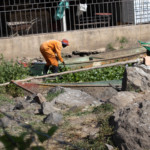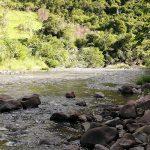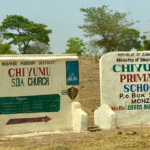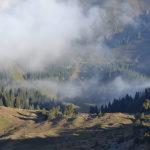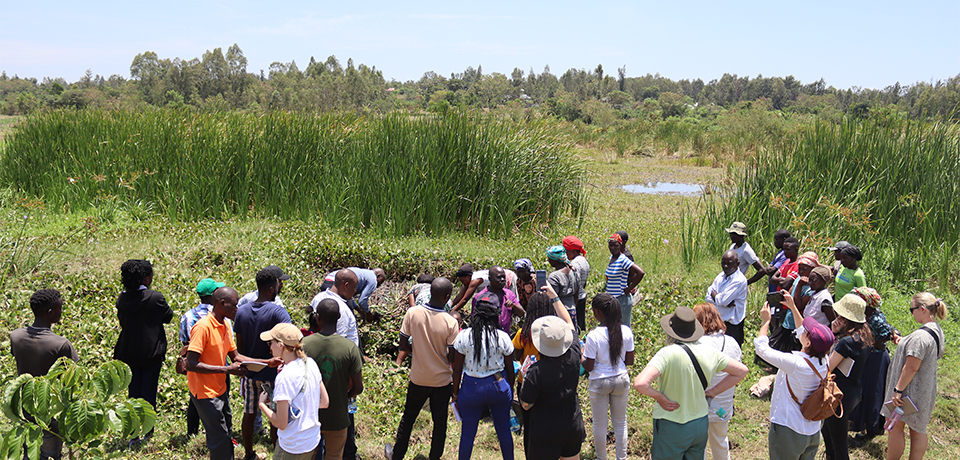
Maija Pyhälammi, Stephen Mwanza, Oryem Naome Juliet, Hyvonne Winnie Kemunto, Asiimwe Mary Gorreti & Satu Määttänen
Water hyacinth, an invasive species in Africa, is insidiously overtaking waterbodies in and around Lake Victoria, simultaneously decreasing the health of the lake and the surrounding environment. To stop the species from further spreading to and multiplying in the waterbodies, local people are taking action. Dala Rieko, a community-based organization in Asembo, western Kenya, is a good example of how a community-based organization (CBO) can start to make a change to solve problems local communities are facing.
During October 2022 we had the privilege to meet some of Dala Rieko members in Asembo Bay Beach, Siaya County, Kenya. The visit was organized as part of a student challenge under the AgriSCALE project. Student challenge is a learning concept – based on problem-based learning –, in which students learn through working in teams for a case commissioned by an actor, such as a private or public institution (Määttänen et al., 2022). The focus of this student challenge was to investigate different opportunities of utilizing water hyacinth in making a bio-based energy such as bioethanol, biogas, and biochar. During a two-week mission in Kenya, our team’s task was to explore the opportunities of utilizing water hyacinth as a component in biogas production. Our team consisted of students from three countries and four universities.
In this article, we share our insights and experiences from the visit and interaction with Dala Rieko members. The article introduces the Dala Rieko CBO and explains their work in eradicating water hyacinth through utilizing it as input for composting.
Dala Rieko – The Home of Knowledge
CBOs are public or private nonprofit organizations that are driven by local community residents often to provide help to socially and economically disadvantaged people in the community (Law Insider, 2018). CBOs can be for example based on a project, in which the residents participate in planning, operating, governing, and implementing the project.
CBOs are considered an effective way to transform lives at a community level. They contribute to sustainable development by using integrated, people-centered and participatory development approaches by organizing and mobilizing communities into action (Miriti, 2009).
Dala Rieko is a Kenyan CBO, based on the shore of Lake Victoria, around 400 kilometers from the country’s capital, Nairobi. Dala Rieko – a Dholuo word meaning “The Home of Knowledge” – was established in 2008, and registered as a CBO in 2015, to offer a community-based development platform for sharing knowledge and good practices among local residents (Dala Rieko, 2023). The CBO aims to support vulnerable groups and individuals within the community, as well as to solve community-wide problems and challenges, such as the ones that the rapid spread of water hyacinth is causing.
Water Hyacinth in Lake Victoria and surrounding waterbodies
Water hyacinth (Eichhornia crasspes), native to South America and invasive in Africa, is a free-floating, rapidly spreading species that forms large, dense mats, disturbing ecosystems and blocking life beneath and above the water surface (Ecowb, 2021). Water hyacinth hampers the livelihood activities of fishermen, blocks access to safe drinking water, and accelerates the spread of water-borne diseases, such as malaria and cholera (Ecowb, 2021).
In Kenya, water hyacinth has found its way to Lake Victoria, the biggest lake in Africa, and is taking over the lake and its waterbodies with speed (Ecowb, 2021). Without eradicating or decimating the plant from the lake, it could eventually take over the whole waterbody of Lake Victoria, destroying the ecosystem and leaving communities without food and income (United Nations, 2020)
From the Dala Rieko members, we came to learn that the swamp in Yimbo village, Asembo, is an important source of water for the locals, but the water hyacinth is slowly choking the swamp and related livelihoods.
Dala Rieko is contributing to the eradication of water hyacinth in waterbodies at the coast of Lake Victoria through utilization. The members of Dala Rieko use the invasive plant to make compost for their agricultural lands (Figure 1). During the student challenge, we had the opportunity to join the farmers in compost making, under the guidance of Dala Rieko Chairman, Mr. Alex Omino.
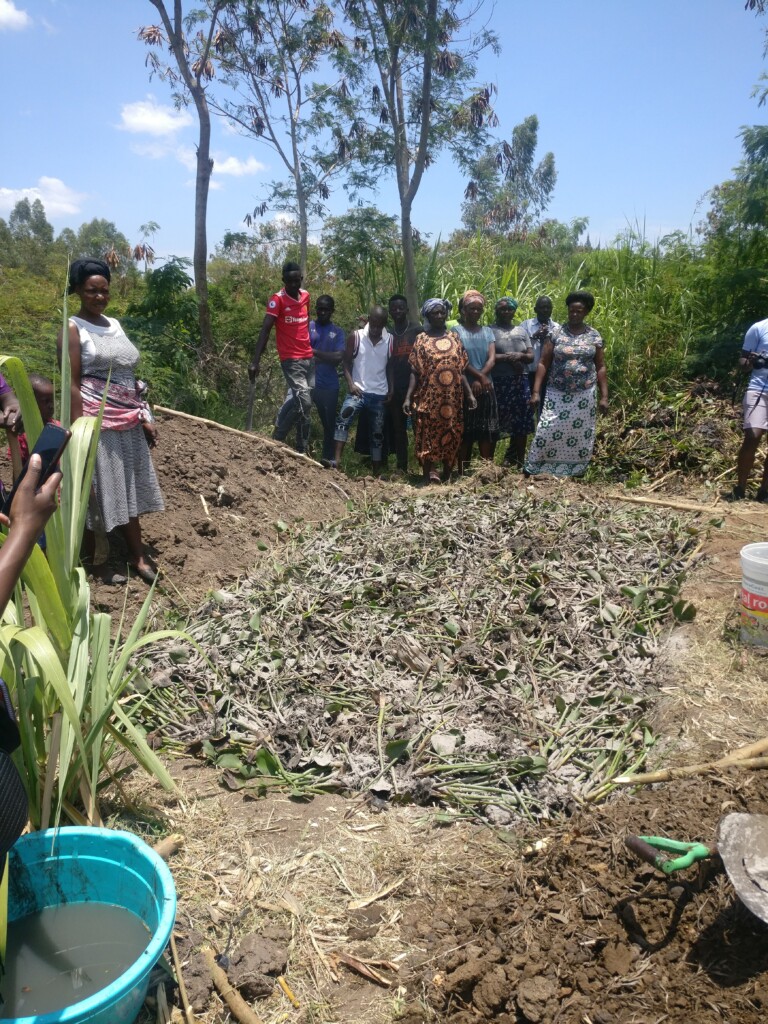
Utilizing water hyacinth for compost
To begin the process of composting, we headed to a nearby swamp – invaded by water hyacinth – in the village of Yimbo, just a few kilometers away from the headquarters of Dala Rieko in Asembo Bay Beach. Together with local villagers, we plucked the water hyacinth. Within estimated 10 minutes we had filled over 100 liters of buckets and basins with water hyacinth.
We took the collected plant to a nearby compost site, about 50 meters away. The members of Dala Rieko had already dug a shallow pit for us for the compost-making and assembled all the necessary materials, such as water, topsoil, cow manure and wood ash. We started the composting process by sprinkling water on the base of the pit, after which dried maize stalk and grass were placed at the bottom as the first layer of the compost (Figure 2). The second layer placed in the pit was a layer of topsoil. The third layer consisted of cow manure, followed up by a layer of water hyacinth. To finish off the compost, wood ash was placed as the final layer on top of the compost, and water was sprinkled on it. In less than thirty minutes we were done with the whole process. We placed one long wooden stick deep into the compost heap to be used for checking on the heat and progress of the composting. As a symbolic gesture of the fruitful collaboration between Africa and Finland during the student challenge, four corner sticks were pushed deep into the ground together by students from each participating university and Dala Rieko members.
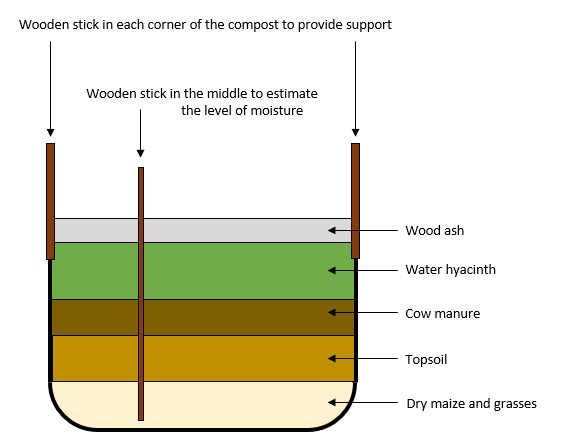
From the Dala Rieko members, we learned that for composting to succeed, it is important to monitor the moisture level, maintain adequate aeration, and use a good mix of materials high in nitrogen and carbon. Turning the heap regularly, once in 2 to 4 weeks, helps to speed up the composting process by allowing more oxygen to reach the microorganisms that break down the organic matter. In warm climates, like in western Kenya, the compost will take around three to four months to be ready.
Double benefits of the compost
Before we left the compost site to continue our field trip, we were introduced to one of the village elders participating in the compost-making. She showed us her farm and the benefits of using the compost. Her maize was green and thriving despite ongoing dry spell in the area (Figure 3).
Dala Rieko members reported that the more they make the compost from the hyacinth from the swamp, the more the swamp is opening up again – slowly but steadily – and regaining its past glory.
The spread of water hyacinth had obstructed the water provision for people and animals alike. Now, the eradication of water hyacinth by utilization has enabled the water resource use for drinking and irrigation in Yimbo village. Thus, the utilization of water hyacinth as compost is bringing double benefits for the Dala Rieko and whole community members: restoring the swamp ecosystem with its ecosystem services and providing fertilization to agricultural lands.
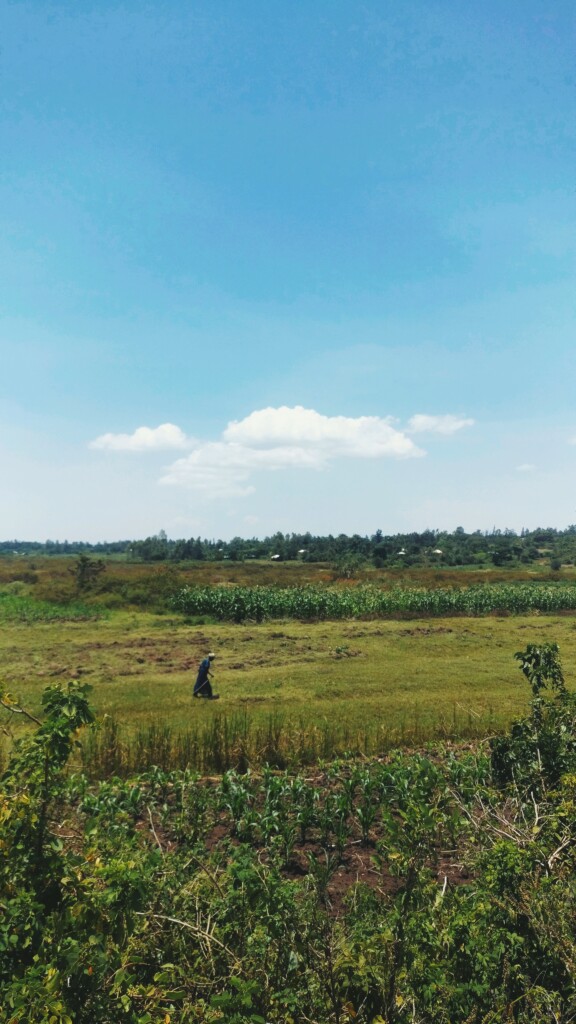
Authors
Maija Pyhälammi, Häme University of Applied Sciences, Bachelor of Natural Resources (Sustainable Development)
Stephen Mwanza, Jomo Kenyatta University of Agriculture and Technology, Bachelor of Agricultural and Biosystems Engineering
Oryem Naome Juliet, Gulu University, Bachelor of Science in Food and Agribusiness
Hyvonne Winnie Kemunto, Egerton University, Agricultural Extension
Asiimwe Mary Gorreti, Gulu University, Bachelor of Science in Agriculture
Satu Määttänen, M.Sc. in Agricultural Sciences and M.Sc. in Environmental Science and Policy from the University of Helsinki. She works as a Research Assistant at Häme University of Applied Sciences in Bio Research Unit.
References
Dala Rieko. (2023). About Us: Our Story. https://dalarieko.co.ke/about-us/
Ecowb. (2021). Kenya Water Hyacinth. https://www.ecowb.org/kenya-water-hyacinth
Law Insider. (2018). Community-Based Organization. https://www.lawinsider.com/dictionary/community-based-organization-cbo
Määttänen, S., Knuutti, U.-M., & Laitinen, E. (2022). Piloting international student challenges: results on students’ perspective. HAMK Unlimited Professional, 26.9.2022. https://urn.fi/URN:NBN:fi-fe2022062047869
Miriti, G. (2009). The Role of Community Based Organizations (Cbos) in Transforming People’s Lives: a Case Study of Omega Child Shelter in Mwingi Central District [University of Nairobi, Kenya]. http://erepository.uonbi.ac.ke/handle/11295/5112
United Nations. (2020). WasteMoney: Water Hyacinth Eradication. https://sdgs.un.org/partnerships/wastemoney-water-hyacinth-eradication

